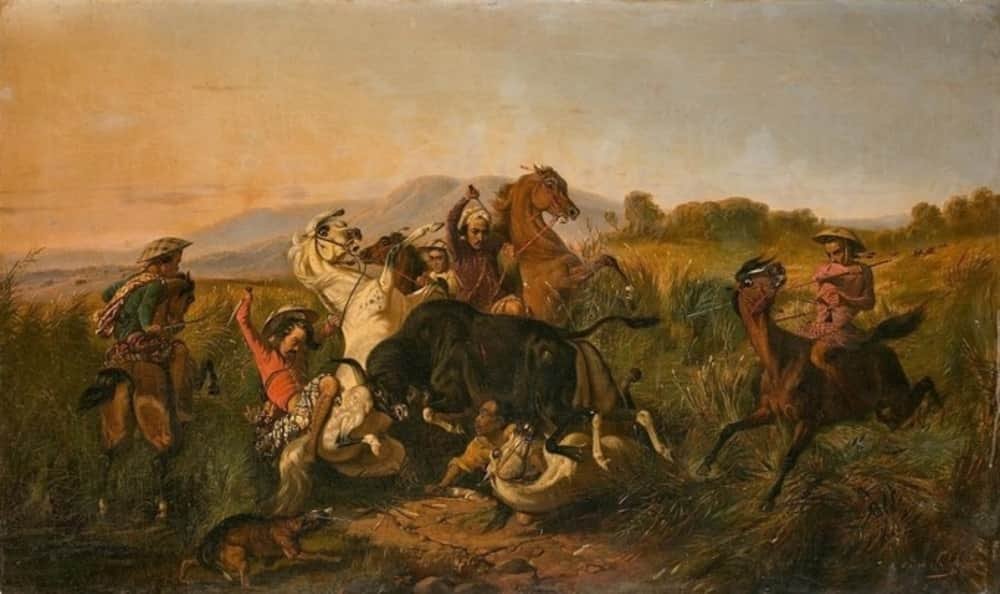Painting The Wild Bull Hunting by Raden Saleh
Painting the Wild Bull Hunting is the work of Raden Saleh, painted with oil on canvas measuring 1.10 × 1.85 m (3.6 x 6 ft). This painting depicts a landscape, bull hunting in a meadow with reeds. The work, complemented by a self-portrait, represents 6 mounted horses, one of which is horned by a wild bull.
Raden Saleh traveled to Europe and returned to Indonesia in 1851, the painting was ordered in 1850 by a wealthy French merchant: Jules Stanislas Sigisbert Cézard installed in Batavia, the current name of Jakarta. While the latter returned to France the canvas was auctioned on May 1, 1859.
In January 2018, during the auction, the starting price was between 150,000 and 200,000 €. Final sales exceeded 7 million Euros.
After being sold, after obtaining permission to leave the territory of France, the work will enter Indonesia.
Biography of Raden Saleh
Raden Saleh Syarif Bustaman was born in 1807 in Semarang on the island of Java in the Dutch East Indies (now Indonesia). He was born into a noble Hadhrami family where his father was Sayyid Husen bin Alwi bin Awal bin Yahya, an Indonesian of Arab descent. He is the grandson of Sayyid Abdullah Bustaman maternally. Raden Saleh is connected to Habib Ali Kwitang through his sister, Roqayah, who is married to Ali Kwitang’s father, Abdurrahman but has no children.
Travel to Europe
Raden Saleh, at a young age was first taught in Bogor by Belgian artist A.J. Payen. Payen recognized the talent of the youth, and persuaded the Dutch colonial government to send Raden Saleh to the Netherlands to study art. He arrived in Europe in 1829 and began studying under Cornelius Kruseman and Andreas Schelfhout.
It was from Kruseman that Raden Saleh learned his skills in portraiture, and was later accepted in various European courts where he was assigned to make portraits. Meanwhile in Europe, in 1836 Saleh became the first indigenous Indonesian to be initiated into Freemasonry. From 1839, he spent five years at the court of Ernest I, Duke of Saxe-Coburg and Gotha, who became an important patron.
From Schelfhout, Raden Saleh developed his skills as a landscape painter. Raden Saleh visited several European cities, as well as Algiers. In The Hague, a lion tamer allowed Raden Saleh to study his lions, and from it the most famous painting of animal fights was made, which later made the artist famous. Many of his paintings are exhibited at the Rijksmuseum in Amsterdam. Several of his paintings were destroyed when the Dutch Colonial pavilion in Paris was burned down in 1931.
While in Paris, Raden Saleh met Horace Vernet, whose paintings are often themed on African wildlife. Compared to Vernet, Saleh’s paintings seem to have been influenced more by the romantic painter Eugène Delacroix. This can be seen in one of Saleh’s works, Hunting Lion, 1840, which has a composition similar to Delacroix’s Liberty Leading the People. However, Werner Kraus, researcher at the Center for Southeast Asian Arts in Passau, Germany, says Saleh “never mentioned Delacroix. Perhaps he saw Delacroix’s work, and perhaps Vernet’s, during the exhibition”.
Read also: Most Famous Paintings in the World
A painting of The Wild Bull Hunting by renowned Indonesian artist Raden Saleh was found in a cellar in France
Titled The Wild Bull Hunting (Bull Hunt), the painting will be auctioned on January 27. Auctioneer Jack-Philippe Ruellan told The Jakarta Post that the painting would have a spare price of €200,000 (US$248,433) and given that a similar painting sold for €1.5 million at Christie’s Singapore in 1996, the hammer price for this work could be around €1.5 million. 1 million.
Like much of Saleh’s art, the subject is the 19th-century “great hunt” of fearsome wild animals. In this work, Saleh himself appears on horseback with a Javanese hunting troupe when they engage wild bulls in Java.
The painting was found in August 2017 in a house in Breton, France.
“The family didn’t know what they had and wanted to get rid of this huge painting,” Ruellan said, adding that the family inherited it from a great aunt who once lived with a diplomat and traveled around the world.
Recognizing the painting’s great value, he began researching with the French gallery Cabinet Turquin, who discovered that it was the fourth addition to three artworks representing themes similar to the Bull Hunt, two of which are in the art collection at the State Palace. .
The painting is believed to be an order from Jules Stanislas Sigisbert Cézard, the son of a wealthy French sugar and coffee trader, who was born in Jakarta (then Batavia) in 1829.
A Pious scholar, Werner Kraus, says that in 1859 Cézard back again to France, selling his house and equipment including Saleh’s work as announced in the Java-Bode newspaper on April 30, 1859, “Een schilderstuk van Raden Saleh voorstellende eene banteng Jagt” (Raden Saleh’s painting represents a bull hunt).
“What attracted me the most when I found the painting was the quality of the composition, the quality of the portrait, the dynamism,” said Ruellan.
Saleh is widely regarded as the first modern artist in Indonesia. He perfected his skills in Holland before receiving recognition in Germany and Paris for Orientalist hunting and fighting.
Agus Dermawan T., art critic and consultant to the palace’s art collection, said hunting was a popular theme in Saleh’s works between 1845 and 1855.
He explained that Saleh’s introduction to wildlife began when he worked as an animal tamer at a circus. Saleh, who admired the work of French artist Eugene Delacroix who also loved painting wildlife, later painted the subject on many canvases.
Agus said the painting looks like a sunset, different from the blue sky seen in the presidential collections.
“This painting style is common in Saleh’s works, such as when painting the explosion of Mount Merapi – in the morning, afternoon, evening, and evening. That’s the business strategy,” he said.
He said the reserve price of €200,000 was reasonable, given the painter’s masterpiece, The Arrest of Prince Diponegoro (1857), which is in the president’s collection, is worth around IDR 80 billion ($6.02 million).
Agus said there were no more than 30 of Saleh’s works in Indonesia, including six at the State Palace.
Sources: PinterPandai, Straits Times
Photo credit: source: https://www.ouest-france.fr/leditiondusoir/2018-01-22/ (Public Domain) via Wikimedia Commons



